How Long to Charge Golf Cart Batteries (Charge Time & How)
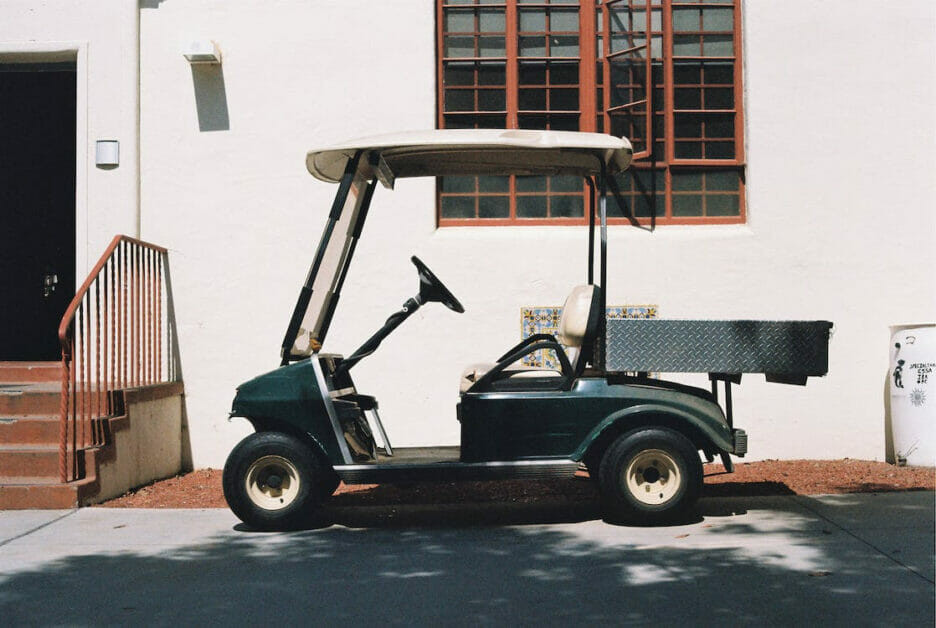
If you own a golf cart, you’ll want to know the best way to charge its batteries according to the particular type it uses and other considerations.
Golf carts use similar batteries as used in other vehicles. But not all have alternators, and some have different voltages (other than 12V).
You charge golf cart batteries similarly to how you would charge other vehicle batteries, as they are typically lead-acid, AGM, gel, or lithium-ion batteries. However, you should use chargers specifically made for golf carts, especially if they are not 12V.
Otherwise, you can use a dedicated battery charger for lead-acid and AGM batteries, let the golf cart’s alternator charge it if it has one, or attach it to a UPS or solar panel system. You normally charge a 12V battery to around 14.1-14.4V at 2-15A. Gel-based batteries have special charging requirements. They must only be charged at a specific voltage level. Lithium-ion batteries should ideally be recharged when their charge falls to 20-50% and occasionally fully discharged to 5%.
Please note these are just estimates, and actual times can vary based on the charger used, the condition of the batteries, and other factors:
| Battery Type | Battery Size (Ah) | Approximate Charging Time |
|---|---|---|
| Lead Acid | 150 Ah | 6-8 hours |
| Lead Acid | 225 Ah | 8-10 hours |
| AGM | 150 Ah | 5-6 hours |
| AGM | 225 Ah | 7-8 hours |
| Lithium-Ion | 150 Ah | 2-3 hours |
| Lithium-Ion | 225 Ah | 3-4 hours |
I’ve also covered battery and charging issues that golf cart owners often face and mentioned other good battery maintenance practices below.
Batteries in Golf Carts
The batteries used in golf carts are the same as those used in other vehicles, so the manner of charging them is also the same.
The most common batteries used in them are lead-acid, AGM, gel, and lithium-ion batteries. Charging them correctly and adhering to a good charging routine is good for maintaining the batteries and ensuring their longevity.
Battery Type Characteristics
| Battery Type | Lifespan | Typical Cost | Maintenance Requirements | Special Notes |
|---|---|---|---|---|
| Lead Acid | 2-5 years | $ | Regular water level checks and refilling required | Widely available and affordable |
| AGM (Absorbed Glass Mat) | 4-7 years | $$ | Limited maintenance required | Charges quicker than Lead Acid offers better leak protection |
| Gel | 2-5 years | $$$ | Limited maintenance required | Requires a specific charger and voltage level |
| Lithium-Ion | 10-20 years | $$$$ | Minimal maintenance required | Quick to charge, lightweight, more expensive |
I’ve grouped them into three according to differences in the manner of charging:
- Charging lead-acid and AGM golf cart batteries
- Charging gel-based golf cart batteries
- Charging lithium-ion golf cart batteries
Before You Start Charging
Before you start charging a golf cart battery, I recommend the following:
- Park the golf cart in a well-ventilated, cool, and dry place.
- Check the water level in the batteries and ensure the vent caps are tight.
- Make sure the cart is turned off.
- Use the right battery charger according to the cart’s total voltage.
Charging Methods for Different Battery Types
| Battery Type | Charging Method |
|---|---|
| Lead Acid | General battery charger, UPS, Solar Panel, or alternator in the golf cart |
| AGM | General battery charger, UPS, Solar Panel, or alternator in the golf cart |
| Gel | Specific gel battery charger |
| Lithium-Ion | Specific lithium-ion battery charger |
Charging Lead-Acid and AGM Golf Cart Batteries
Lead-acid batteries are widely available and comparatively affordable but heavy.
They last about 2-5 years. AGM (Absorbed Glass Mat) batteries are similar but have absorbable electrolytes and fiberglass plates, allowing charging up to five times quicker. They also offer better protection against leaks and last longer.
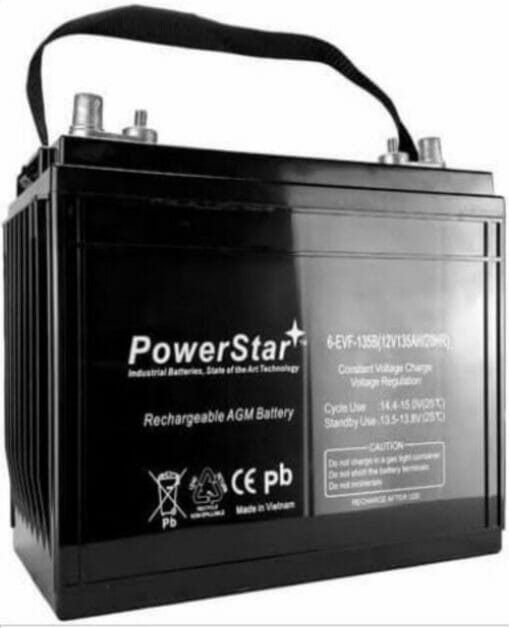
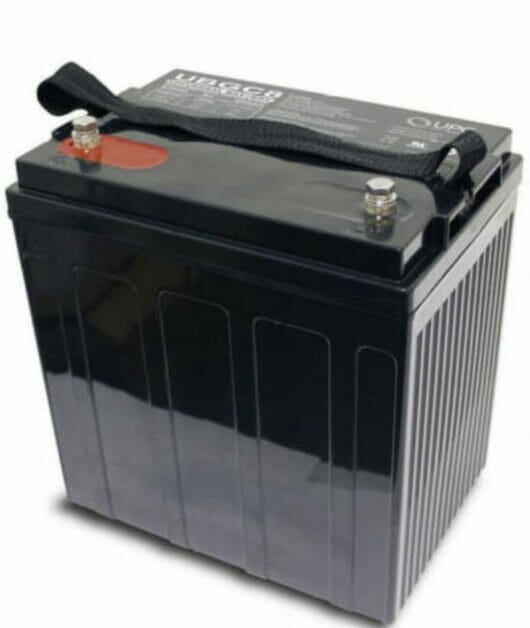
A lead-acid (left) and AGM (right) golf cart battery
Charging Method
You have three options when charging a lead-acid or AGM-type golf cart battery.
You can use a general battery charger, let the golf cart charge the battery, or use a UPS or solar panel.
Charging Using a General Battery Charger
To charge it using a general battery charger, detach the battery, attach the charger’s cables to the battery, plug in the charger, then set it before pressing the start button.
Attach the red cable to the battery’s positive terminal and the black one to a metallic engine part.
Charge a 12V battery to about 14V. Check the manufacturer’s recommendation for the exact maximum, which may be 14.2-14.4 volts. A safe current to apply is 2-5A, but you can go up to 10-15A for quicker charging. The charger will automatically switch to “Maintenance” mode when done.
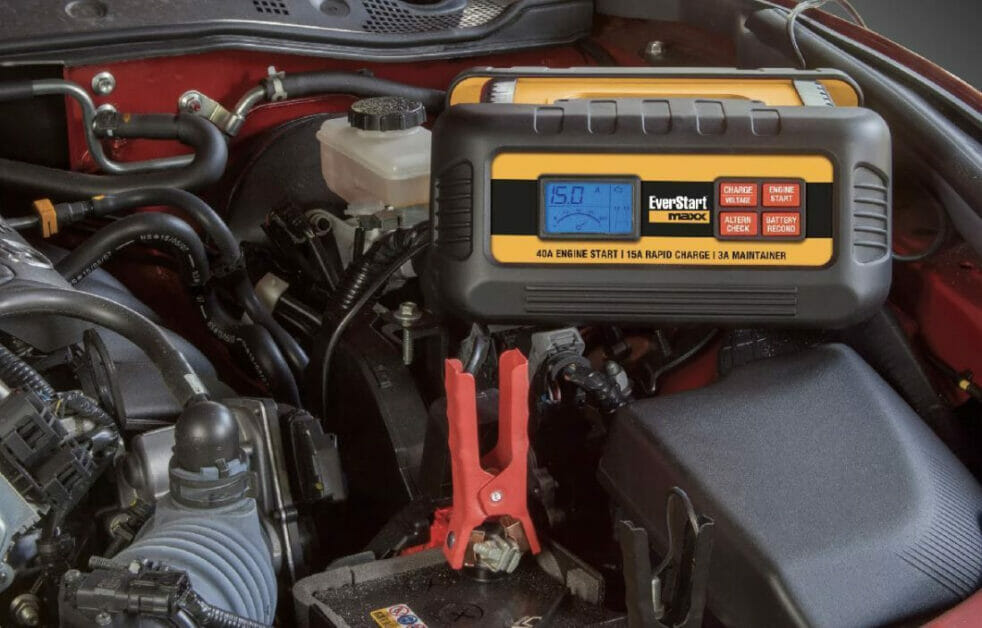
Charging Using the Golf Cart
To let the golf cart’s alternator charge the lead-acid battery, leave the battery inside and simply drive the golf cart for a while.
This method will only work if the golf cart has an alternator, as not all golf carts do, and if the battery has enough charge to start it. If not, you will need to jump-start it using another battery. The electrical energy generated mechanically while driving the golf cart will be stored in the fixed battery.
I recommend you drive the golf cart for at least half an hour to one hour to charge the battery.
Charging Using a UPS or Solar Panel System
Charging a golf cart battery using a UPS or solar panel system is yet another option.
Connect the battery in parallel to the existing battery in the system. It will charge more efficiently than connecting the battery in series, although it will take longer.
Charging Gel-Based Golf Cart Batteries
Gel-based batteries used in golf carts require less maintenance than regular lead-acid batteries.
However, they have special charging requirements and have been set apart from regular lead-acid and AGM batteries. They are delicate and can easily get damaged if charged improperly or overcharged.
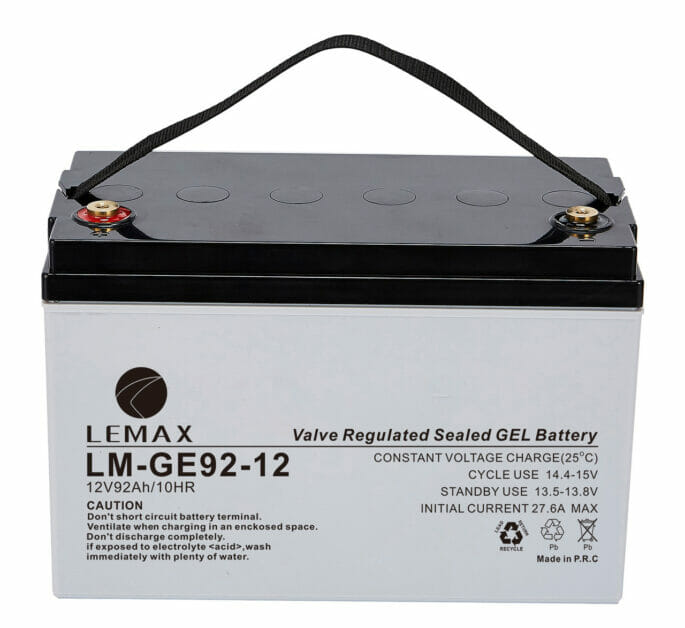
Charging Method
A gel-based golf cart battery is best charged using a smart charger designed for it and following the manufacturer’s recommendations.
You can use other non-smart battery chargers but must apply a constant charging voltage, which may lie within the range of 14.1-14.4V. Check the battery manufacturer’s recommendation because it must be an exact value and neither higher nor lower than it.
Then, continuously monitor the process to avoid overheating and overcharging. They must also be ones specially designed for gel batteries. Don’t risk using an ordinary charger; otherwise, the battery may overheat and lose its capacity to retain a charge.
Also, apply a low current to charge them slowly and steadily. If the gel battery has a very low charge, you may need to apply the desulfation mode available on the smart charger. You can charge it quicker at a higher current if you want, but you must be extra careful in monitoring the temperature and charge. Instead, I recommend “float charging” to help avoid overcharging.
Immediately disconnect the charger when the gel battery is fully charged to prevent overcharging.
An Example of a Gel Battery Charger
An example of a special charger for charging gel-based golf cart batteries is shown in the picture below.
Such chargers have a built-in microprocessor that continuously monitors and adjusts the charging process to ensure optimal charging.
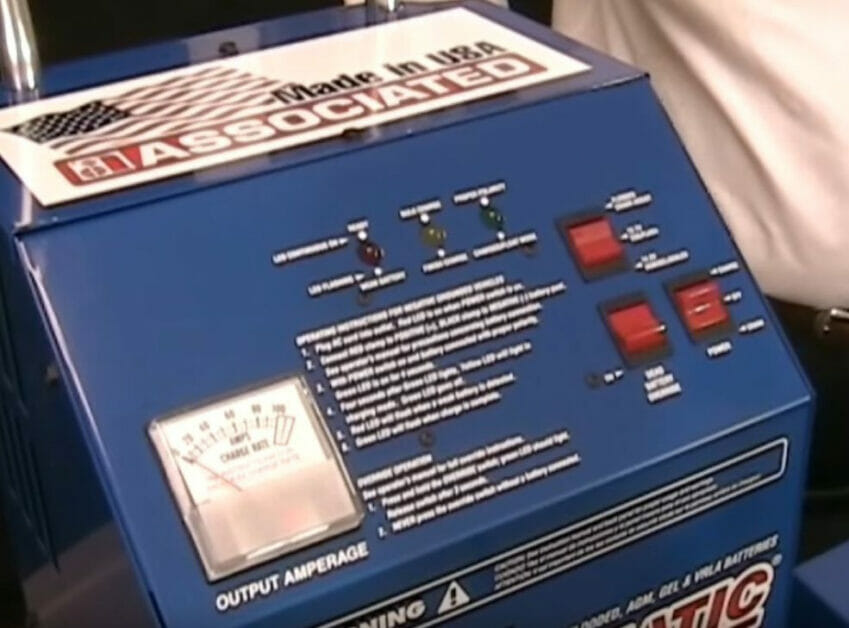
Charging Lithium-Ion Golf Cart Batteries
Lithium-ion batteries offer several advantages over traditional lead-acid, AGM, and gel-based golf cart batteries.
They are ideal for golf carts for their lighter weight but are far more expensive. They also last much longer (10-20 years).
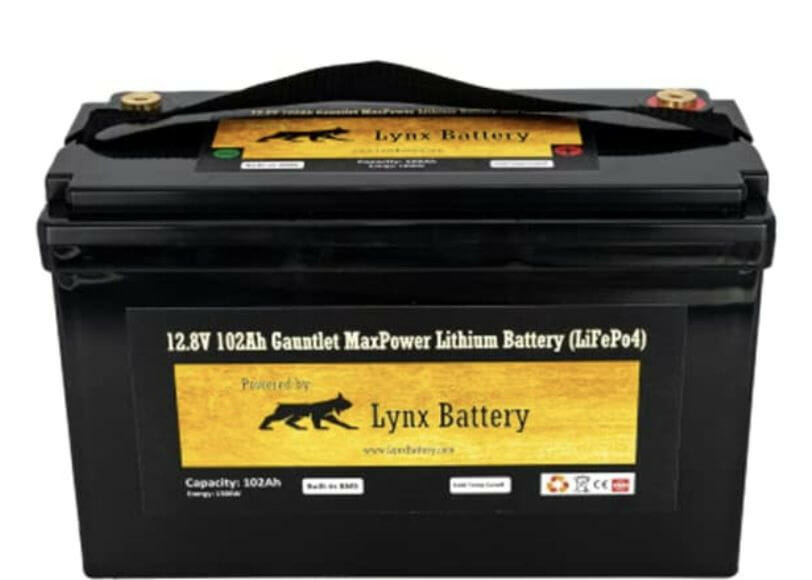
Charging Method
An ideal charging routine for lithium-ion golf cart batteries is to apply a routine of shallow discharges and recharges while occasionally allowing it to undergo a full discharge.
Shallow discharges and recharges put less stress on the battery. Recharge fully (or a little less than 100%) when the charge falls to 50%, whenever possible, or no less than 20%. Allow the full discharge (to 5%) about once a month.
Lithium-ion batteries typically have built-in safeguards to prevent them from exploding if left charging at maximum capacity. However, protect them from exposure to temperature extremes (freezing and very hot conditions). So, avoid parking the golf cart in direct sunlight, prefer parking in shaded areas, and select warm and dry areas in winter.
Battery and Charging Issues
Here, I will address some common charging issues golf cart owners face.
Common Battery Issues and Their Solutions
| Issue | Potential Cause | Solution |
|---|---|---|
| Battery not charging | Poor connection or a faulty charger | Check connections, try a different charger |
| Short battery life | Overcharging or undercharging | Follow proper charging guidelines for your battery type |
| Battery leaking | Overfilling in the case of Lead Acid batteries | Be careful not to overfill when adding water |
| Battery overheating | Overcharging or using the wrong charger | Use the correct charger, avoid overcharging |
36V and 48V Golf Cart Batteries
If you have a 36V or 48V golf cart, you should use a specially designed-charger.
One example is the EZGO TXT Medalist charger, which has an 8-foot cord, a two-speed cooling fan, and an LED indicator.
Method: Connect the battery to the charger, plug it into a fixed outlet, and switch it on.
Indications: A red light indicates an active AC power supply, a yellow light indicates that charging is in progress, and a green light indicates the charging is complete.
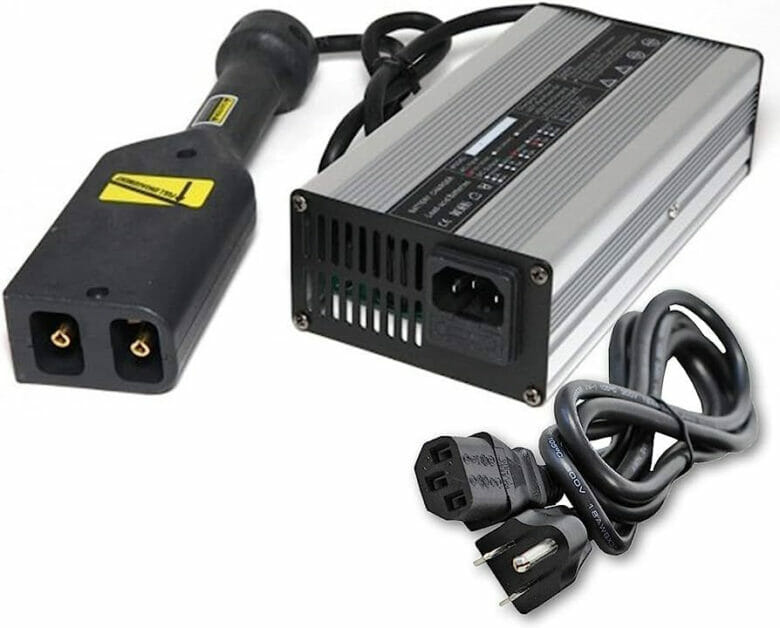
Different Voltage
If you have a 12V charger, which is common, but 6V batteries in your golf cart, you can use the charger to charge them quickly.
Charging Tips for Different Voltage Batteries
| Battery Voltage | Charging Tip |
|---|---|
| 36V or 48V | Use a charger specially designed for this voltage |
| 6V (multiple) | Charge in pairs using a 12V charger |
| 8V | Charge individually for only half an hour using a 12V charger |
You will typically have multiple 6V batteries connected in series. So, the method is to charge them in pairs because two 6V batteries in series are designed to provide a total of 12V. This method can also be used to help revive dead batteries.
This will take longer because you must charge each pair, but it will do the job. The alternative is to get the right charger for your particular setup or use a variable charger to provide the required voltage.
For a pair of 6V batteries, do this for about one hour. If you have 8V batteries, you can still use the 12V charger but charge them individually for only half an hour.
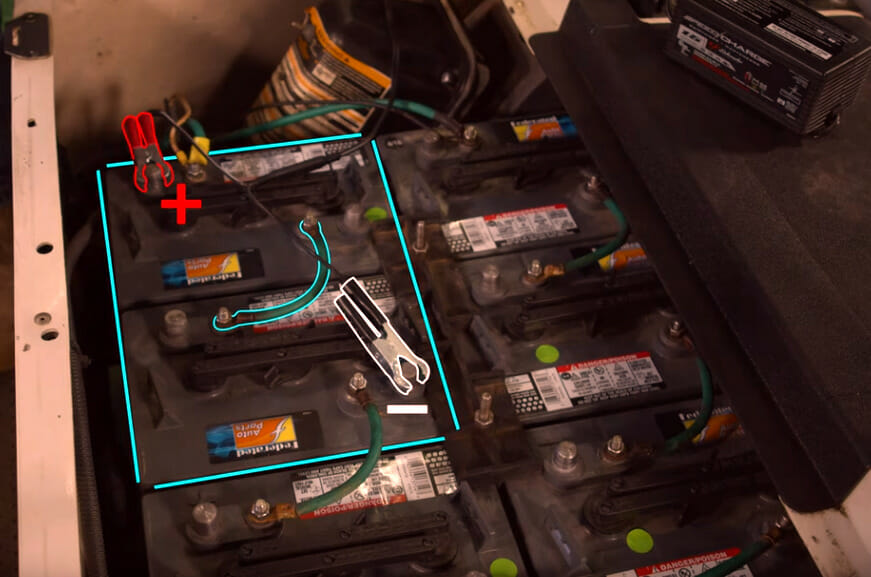
Battery not Charging
A smart charger is designed to detect problems with the battery, if any.
It can usually indicate the reason why a battery fails to charge. But, an ordinary charger might appear not to work if charging after a prolonged time. This usually happens after a long absence of using the golf cart.
The battery’s charge level declines naturally due to self-discharging (up to 20% monthly). If more than a few months have passed or it’s the winter season, the charge may have fallen too low to start the golf cart or even be recharged easily.
The battery is most probably heavily sulfated. You can confirm this if you notice white patches on the battery’s exterior. Otherwise, the only other reasons for not charging would be if the battery is damaged or dead. You can suspect it may be dead if its expected lifespan is over or nearly over. So, assuming the battery is neither damaged nor dead, it should be possible to recharge it.
The solution is to de-sulfate the battery first before attempting to recharge it. The charger is more likely to recognize the battery and start charging once it is de-sulfated. A battery expert best does proper desulfation. However, some chargers provide an option to send short high-current passes to desulfate the battery, which may help to get it charging again.
Variable Charging
Variable charging is usually applied by first charging at a high rate, i.e., current, to charge the battery quickly, then reducing the rate towards the end to charge it fully.
If the golf cart battery struggles to charge, you can try this method, but you should monitor the charging process to prevent overcharging. I suggest you initially charge at around 10-12V (max. 15V), then float charge at around 2-5V when the battery is closer to being fully charged (90-95%).
Other Good Battery Maintenance Practices
Apart from charging golf cart batteries the right way, here are some other good battery maintenance practices:
- Adhere to a good charging routine.
- Use the golf cart battery no more than five times a week.
- Clean the battery frequently.
Avoid things that can damage the battery or shorten its lifespan by observing the following:
- Don’t let the water level run low (this only applies to wet-cell, lead-acid batteries). Maintain the battery’s water level up to the required level. Only use distilled water.
- Don’t let corrosion build up on the battery’s terminals or let them rust.
- Don’t use the battery heavily or roughly.
- Don’t let the battery overcharge.
- Don’t let the two terminals short-circuit.
References
AGM golf cart batteries. https://www.powerstridebattery.com/8-volt-agm-golf-cart-battery.
EZGO TXT Medalist, 36V trickle charger for golf carts. https://www.amazon.ca/Battery-Charger-Medalist-Trickle-Charge/dp/B01N3CVVDC
Gel battery. https://www.gz-supplies.com/emergency-power-system-lead-acid-deep-cycle-gel-battery-gel-12v92ah-lemax/
Lead acid golf cart battery. https://www.amazon.com/POWERSTAR-Replacement-Trojan-Flooded-Battery/dp/B0B3ZFD7FT
Lithium-ion golf cart battery. https://www.amazon.com/Golf-Battery-Lithium-Conversion-100Ah/dp/B0BD2VYJVV
Using Everstart battery charger. https://www.walmart.com/ip/EverStart-Maxx-15-Amp-Battery-Charger-and-Maintainer-with-40-Amp-Engine-Start-BC40BE/438914356
Video References
Associated Equipment
DIY Golf Cart
